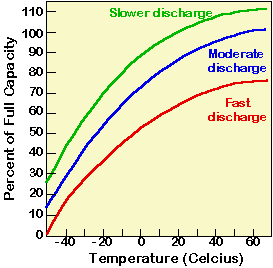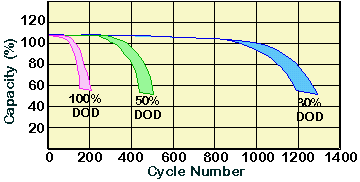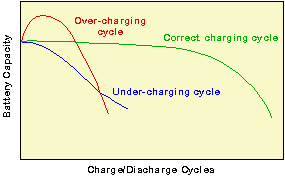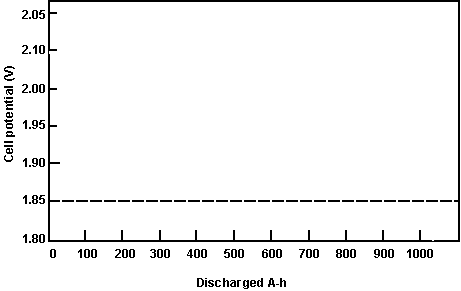For most renewable energy systems, the most important battery characteristics are the battery lifetime, the depth of discharge and the maintenance requirements of the battery. This set of parameters and their inter-relationship with charging regimes, temperature and age are described below.
Depth of Discharge and Battery Capacity
The depth of discharge in conjunction with the battery capacity is a fundamental parameter in the design of a battery bank for a PV system, as the energy which can be extracted from the battery is found by multiplying the battery capacity by the depth of discharge. Batteries are rated either as deep-cycle or shallow-cycle batteries. A deep-cycle battery will have depth of discharge greater than 50%, and may go as high as 80%. To achieve the same useable capacity, a shallow-cycle battery bank must have a larger capacity than a deep-cycle battery bank.
In addition to the depth of discharge and rated battery capacity, the instantaneous or available battery capacity is strongly affected by the discharge rate of the battery and the operating temperature of the battery. Battery capacity falls by about 1% per degree below about 20°C. However, high temperatures are not ideal for batteries either as these accelerate aging, self-discharge and electrolyte usage. The graph below shows the impact of battery temperature and discharge rate on the capacity of the battery.

Battery Lifetime
Over time, battery capacity degrades due to sulfation of the battery and shedding of active material. The degradation of battery capacity depends most strongly on the interrelationship between the following parameters:
- the charging/discharging regime which the battery has experienced
- the DOD of the battery over its life
- its exposure to prolonged periods of low discharge
- the average temperature of the battery over its lifetime
The following graph shows the evolution of battery function as a number of cycles and depth of discharge for a shallow-cycle lead acid battery. A deep-cycle lead acid battery should be able to maintain a cycle life of more than 1,000 even at DOD over 50%.

In addition to the DOD, the charging regime also plays an important part in determining battery lifetime. Overcharging or undercharging the battery results in either the shedding of active material or the sulfation of the battery, thus greatly reducing battery life.

The final impact on battery charging relates to the temperature of the battery. Although the capacity of a lead acid battery is reduced at low temperature operation, high temperature operation increases the aging rate of the battery.


Constant current discharge curves for a 550 Ah lead acid battery at different discharge rates, with a limiting voltage of 1.85V per cell (Mack, 1979). Longer discharge times give higher battery capacities.
Maintenance Requirements
The production and escape of hydrogen and oxygen gas from a battery cause water loss and water must be regularly replaced in lead acid batteries. Other components of a battery system do not require maintenance as regularly, so water loss can be a significant problem. If the system is in a remote location, checking water loss can add to costs. Maintenance-free batteries limit the need for regular attention by preventing or reducing the amount of gas which escapes the battery. However, due to the corrosive nature the elecrolyte, all batteries to some extent introduce an additional maintenance component into a PV system.
Battery Efficiency
Lead acid batteries typically have coloumbic efficiencies of 85% and energy efficiencies in the order of 70%.
Lead Acid Battery Configurations
Depending on which one of the above problems is of most concern for a particular application, appropriate modifications to the basic battery configuration improve battery performance. For renewable energy applications, the above problems will impact the depth of discharge, the battery lifetime and the maintenance requirements. The changes to the battery typically involve modification in one of the three basic areas:
- changes to the electrode composition and geometry
- changes to the electrolyte solution
- modifications to the battery housing or terminals to prevent or reduce the escape of generated hydrogen gas.
